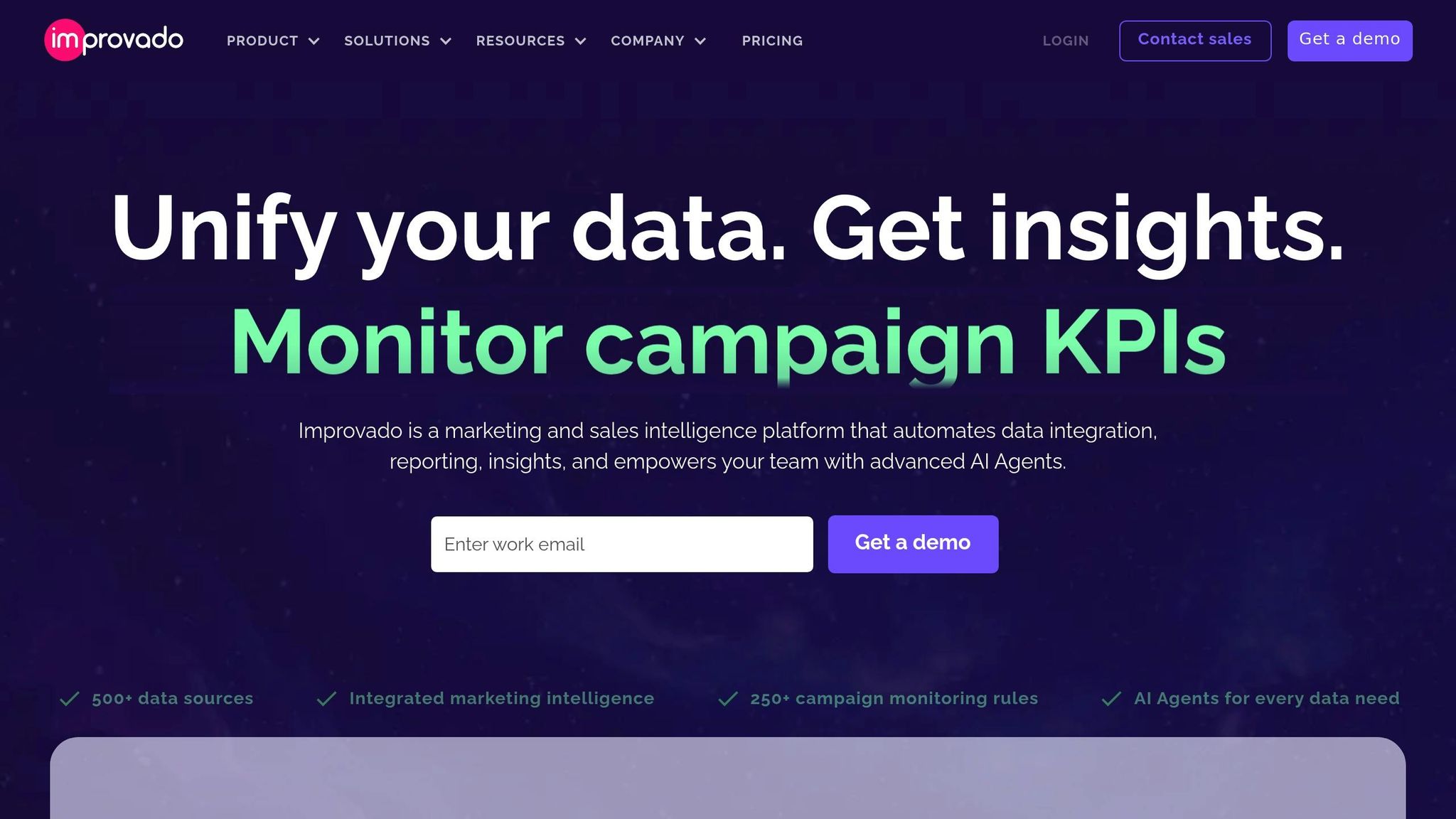Cross-channel reporting is tough because every platform tracks data differently - like email "opens" versus ad "clicks." The solution? Standardizing your data. This means aligning metrics, naming conventions, and formats across all channels, so you can compare performance without endless manual fixes.
Key tools to help:
- Improvado: Automates data integration and standardization for large teams. Connects 500+ platforms and simplifies reporting.
- Claravine: Focuses on data governance at the source. Ensures clean, consistent data before it hits your analytics tools.
- Marketing Analytics Tools Directory: A resource to find tools tailored to your reporting needs, with both free and paid options.
Each tool has its strengths depending on your team's size, budget, and goals. Standardized data not only saves time but also ensures accurate, actionable insights for smarter marketing decisions.
Cross-channel marketing reports on Google Looker Studio (2024): GA4+ Google Ads + FB Ads - Tutorial

1. Improvado

Improvado stands out as a robust tool designed for enterprise-level teams, simplifying the complexities of cross-channel reporting through extensive automation. By connecting to over 500 marketing, sales, and customer data sources, it creates a centralized analytics hub, removing the need for tedious manual data consolidation efforts.
Here’s a closer look at Improvado’s strengths in data integration, standardization, and scalability.
Data Integration Capabilities
Improvado excels at automatically gathering data from a wide variety of sources, including popular ad platforms, CRM systems, and web analytics tools. Its end-to-end data pipeline ensures seamless data flow - from extraction to actionable insights - without the bottlenecks caused by manual exports or API constraints. The platform also offers flexible storage options and data warehouse management, making both historical and real-time data readily available for analysis. This automated system speeds up the data integration process by 75% compared to traditional manual methods.
Standardization Support
To streamline data from multiple sources, Improvado uses an automated transformation framework. This framework standardizes naming conventions, aligns metrics, and combines data for accurate cross-channel comparisons. With over 250 pre-built compliance rules, it ensures real-time data quality monitoring while also allowing marketers to create custom rules and receive automated alerts for any inconsistencies.
Roman Vinogradov, VP of Product at Improvado, highlights the platform’s role in simplifying cross-platform data management:
"While Improvado doesn't directly adjust audience settings, it supports audience expansion by providing the tools you need to analyze and refine performance across platforms: ... Cross‐platform data integration: With larger audiences spread across platforms, consolidating performance metrics becomes essential. Improvado unifies this data and makes it easier to spot trends and opportunities."
Scalability for Business Sizes
Built for enterprise marketing teams managing large-scale data, Improvado supports advanced marketing attribution models, including single-touch, multi-touch, and custom frameworks. These capabilities help businesses understand how different channels contribute to conversions. Companies using Improvado have reported a 73.8% improvement in optimizing their marketing spend. By quickly identifying underperforming channels, teams can reallocate budgets more effectively using standardized performance data. This approach removes technical hurdles, enabling marketers to focus on strategy rather than the intricacies of data preparation.
Next, we’ll take a look at how Claravine enhances data standardization for cross-channel reporting.
2. Claravine

Claravine tackles the challenge of ensuring consistent, high-quality data by standardizing it before it enters reporting tools. Unlike integration-focused solutions that merely connect data sources, Claravine emphasizes data governance at the source. This proactive approach helps prevent the common pitfalls of poor data quality in cross-channel analytics.
By serving as a central hub for data standards, Claravine ensures uniformity across channels and campaigns, eliminating the need for tedious data cleanup later. Standardizing data at the outset simplifies reporting and ensures accuracy.
Standardization Support
At the heart of Claravine’s platform is its powerful standardization framework. It allows teams to enforce consistent naming conventions, campaign taxonomies, and metadata standards across all marketing channels. This includes aligning elements like campaign names, UTM parameters, creative tags, and audience segments.
The Data Standards Cloud takes this a step further by enabling teams to create custom taxonomies that validate data inputs automatically before campaigns are launched. Instead of discovering inconsistencies during reporting, teams can address them during campaign setup. Approval workflows ensure all campaign data aligns with established standards before activation.
For cross-channel reporting, this approach means data from platforms like Facebook Ads, Google Ads, and email campaigns enters analytics tools already harmonized and ready for direct comparison. This eliminates headaches caused by inconsistent naming conventions across platforms.
Data Integration Capabilities
Building on its standardization capabilities, Claravine enhances existing integrations by ensuring incoming data meets quality standards. While it’s not a data integration tool itself, Claravine complements your marketing tech stack by improving the quality of data flowing into tools like Google Analytics, Adobe Analytics, and various business intelligence platforms.
The Campaign Manager tool integrates with major advertising platforms, enforcing data standards as campaign data flows into reporting tools. With support for over 40 marketing and advertising platforms, Claravine ensures consistent data practices across your entire ecosystem.
Additionally, the platform offers real-time monitoring of data quality. Teams receive alerts when campaigns or data inputs fail to meet established standards, helping to prevent inaccuracies from affecting cross-channel reporting.
Scalability for Business Sizes
Claravine is designed to scale with businesses of all sizes. Smaller teams can start with basic naming conventions and gradually adopt more sophisticated taxonomies as their needs grow. Larger enterprises can implement complex approval workflows to manage operations across multiple brands, regions, and product lines.
With role-based controls and bulk management features, Claravine simplifies oversight for organizations running hundreds of campaigns across various channels, all while maintaining strict adherence to data quality requirements.
The audit trail functionality adds another layer of transparency, offering full visibility into data governance decisions. This feature is especially valuable for larger organizations, as it helps track the impact of standardization efforts on reporting accuracy.
Next, we’ll explore how the Marketing Analytics Tools Directory supports these efforts.
sbb-itb-5174ba0
3. Marketing Analytics Tools Directory
The Marketing Analytics Tools Directory is designed to help teams discover top-notch marketing analytics tools, making it easier to create a reliable and streamlined reporting system.
Data Integration Capabilities
This directory simplifies the search for tools equipped with built-in data integration features. By categorizing tools based on essential functionalities like real-time analytics, campaign tracking, and business intelligence, it helps marketing teams identify solutions that consolidate data from multiple channels. For businesses setting up cross-channel reporting systems, the directory provides detailed insights into each tool’s strengths, reducing the trial-and-error process. This feature-focused approach ensures that teams can find tools that prioritize data consistency.
Standardization Support
To promote consistent reporting, the directory highlights tools that follow widely accepted data practices. Its clear and organized listings make it easy for businesses to pinpoint analytics solutions that align with best practices for maintaining uniformity in data management. This structured setup not only supports unified data handling but also enhances cross-channel reporting capabilities, working hand-in-hand with the integration features mentioned earlier.
Scalability for Business Sizes
What makes the directory even more versatile is its dual listing structure, catering to businesses of all sizes. Small businesses can explore free listings to find budget-friendly tools tailored to their needs, while larger enterprises can benefit from featured listings that provide more detailed insights and greater visibility. Whether a company is just starting out or managing complex, multi-brand reporting, the directory ensures access to tools that can grow and adapt alongside their needs.
Advantages and Disadvantages
When it comes to cross-channel reporting with standardized data, each solution comes with its own set of strengths and challenges. Businesses need to carefully evaluate these trade-offs to choose the right analytics infrastructure.
Improvado streamlines data transformation by automating manual processes. However, its advanced capabilities come with higher costs and setup time, making it a better fit for larger teams with more resources.
Claravine focuses on enforcing standardized naming conventions, ensuring consistency across data. On the flip side, adopting this tool often requires teams to adjust their workflows and invest in training to fully leverage its features.
For those exploring alternatives, the Marketing Analytics Tools Directory (https://topanalyticstools.com) offers a practical option. This directory serves as a cost-effective resource for discovering tools that support data standardization. While it doesn’t process data itself, it provides a curated list of tools tailored to different budgets and business sizes, giving businesses the flexibility to find solutions that match their needs.
| Solution | Integration | Standardization | Scalability | Cost |
|---|---|---|---|---|
| Improvado | Automated handling for complex setups | Strong focus on data transformation | Ideal for enterprises | Higher investment |
| Claravine | Data governance and taxonomy-focused | Enforces naming conventions | Suited for medium to large teams | Moderate investment |
| Marketing Analytics Tools Directory | Curated resource for tool discovery | Highlights tools with standardization features | Fits various business sizes | Varies: Free and paid options |
Maintaining consistency often requires adjustments to workflows and staff training. Enterprise-focused tools like Improvado provide powerful automation but typically demand higher budgets and longer implementation times. In contrast, the Marketing Analytics Tools Directory shifts the responsibility of tool evaluation to the user, enabling businesses to choose solutions that align with their specific operational needs. These considerations highlight the importance of tailoring your analytics approach to your team’s size and financial resources.
Final Thoughts
Choosing the best cross-channel reporting solution comes down to aligning it with your specific business needs. The comparison of tools like Improvado, Claravine, and the Marketing Analytics Tools Directory highlights that there’s no universal solution - it depends on what fits your goals and processes.
For marketers in the U.S., data quality and consistency should be top priorities. Automated validation ensures your data stays clean and accurate. Integrating platforms like Google Ads, Google Analytics, social media, CRM systems, and email tools helps break down data silos, offering a unified view of your customers.
Beyond integration and accuracy, compliance and automation are key to simplifying reporting. Make sure your tools support regulations like CCPA and GDPR by providing clear audit trails, which help minimize compliance risks. Automation can also take the heavy lifting out of data tasks - handling cleansing, transformation, and reporting processes efficiently.
FAQs
How does standardizing data improve cross-channel reporting accuracy?
Standardizing data means organizing all the information collected from various channels into a consistent format, structure, and set of metrics. By doing this, you can eliminate discrepancies and minimize errors, making it much simpler to merge and analyze data from different sources.
When data is standardized, businesses can achieve a clearer and more accurate picture of customer behavior and how campaigns are performing. This streamlined view helps uncover actionable insights, enhances attribution accuracy, and supports smarter decisions for refining marketing strategies.
How do Improvado and Claravine differ in their approach to data standardization and integration?
Improvado is all about streamlining data standardization on a large scale. With over 500 pre-built connectors, it allows for smooth integration and transformation of data from multiple sources. Tasks like normalization and governance become much more manageable, reducing the need for extensive engineering resources while ensuring datasets remain consistent and accurate.
Claravine takes a different approach, focusing on metadata standardization. It offers customizable templates, AI-driven content enrichment, and governance tools to maintain consistency. Its no-code automation makes it easy to enforce data standards across marketing workflows, ensuring a unified approach to data across various systems.
To sum it up, Improvado shines in large-scale integration and automation, while Claravine is your go-to for creating a unified data framework within marketing operations.
What advantages does the Marketing Analytics Tools Directory offer small businesses for cross-channel reporting?
The Marketing Analytics Tools Directory offers small businesses a thoughtfully selected list of platforms aimed at simplifying cross-channel reporting. These tools bring data from various channels together, making it easier to understand customer behavior, measure campaign success, and identify useful insights.
By focusing on the needs of small businesses, the directory helps streamline the process of selecting tools that enable smarter, data-based decisions. These tools not only enhance marketing strategies but also make delivering personalized customer experiences more manageable - without the hassle of juggling multiple systems.


